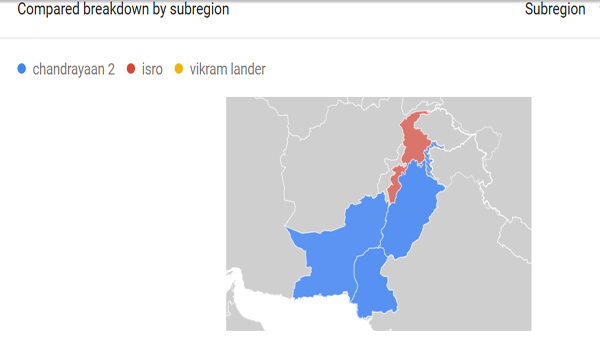Perpetually Pessimist: Pakistanis' Search On Chandrayaan-2 Vikram Lander Spikes After Setback

New Delhi: People in Pakistan have always been interested in India. However, their recent interest is not just limited to Kashmir. Pakistan's leadership may have a political interest in mocking Isro's Chandrayaan-2 mission on Twitter and in the media, but that doesn't seem to have made the ordinary Pakistani uninterested in searching about India's Moon mission.
Yes you read it right. The Google Trends analysis data for the search term 'Chandrayaan 2' on and around September 7 shows that people in Pakistan were actively googling Isro's ambitious Moon mission Chandrayaan-2

.

Google Trends analysis data for the search term 'Chandrayaan 2' on and around September 7
The tool helps analyse the relative frequency of any search term over time on a scale of zero to 100, where 100 represents the highest level.

The data shows that people were searching for "Chandrayaan-2" in different parts of the our neighbouring country, Pakistan. Interest in it was the highest for Chandrayaan 2 started increasing around 12.30 am on September 7. After this, search interest on Chandrayaan 2 witnessed a remarkably steep rise and reached its peak at 2.30 am.

Earlier too, in Pakistan, the search term Kashmir was queried about three times more in August than it was in February.
The search interest graph (below) shows that interest rose with rapid developments in Vikram's trajectory and its coverage by news media. Around 1.37 am, Vikram's landing process started.
In a tweet, Isro said the powered descent phase had started and the first part -- rough braking -- was underway.
At 1.49 am, ISRO tweeted that the rough braking phase had been successfully completed and the fine braking phase had started. At ISRO's control centre in Bangalore, scientists could be seen smiling and clapping.

The Vikram Lander came agonisingly close on the lunar surface, but after journeying millions of kilometres, the Vikram lander lost contact in the final few hundred metres and crash-landed on the lunar surface.
On 2 September, the Vikram lander separated and began to make its descent. All communications were normal until the lander was within 2 km of its goal.
Then it went silent - a space engineer's worst nightmare. But all hope was not lost, as Chandrayaan 2 remained in orbit above the Moon and, with its high-resolution camera, was able to spot the lander. If oriented favourably, Vikram could still manage to power itself up.
Meanwhile, National Aeronautics and Space Administration (NASA) probe will fly over the landing site of lander Vikram on the Moon on Tuesday, September 17. As it flies over the landing site, new information on Vikram lander is expected to emerge. Indian Space Research Organisation (ISRO) has been trying to establish contact with the lander since all communications snapped moments before the scheduled landing on September 7.
Why Is There A Race To Build A Base On The Moon?
NASA's Lunar Reconnaissance Orbiter (LRO) is also likely to release images of the lander Vikram, as mentioned in reports by US media. Noah Petro, LRO's project scientist told spaceflightnow that NASA will share images to help ISRO's analysis of the Chandrayaan 2 mission. "NASA will share any before and after flyover imagery of the area around the targeted Chandrayaan-2 Vikram lander landing site to support analysis by the Indian Space Research Organisation," said Petro.



No comments:
Post a Comment